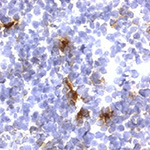EGCG, a major green tea catechin suppresses breast tumor angiogenesis and growth via inhibiting the activation of HIF-1α and NFκB, and VEGF expression
Main Article Content
Abstract
The role of EGCG, a major green tea catechin in breast cancer therapy is poorly understood. The present study tests the hypothesis that EGCG can inhibit the activation of HIF-1α and NFκB, and VEGF expression, thereby suppressing tumor angiogenesis and breast cancer progression. Sixteen eight-wk-old female mice (C57BL/6 J) were inoculated with 10^6 E0771 (mouse breast cancer) cells in the left fourth mammary gland fat pad. Eight mice received EGCG at 50–100 mg/kg/d in drinking water for 4 weeks. 8 control mice received drinking water only. Tumor size was monitored using dial calipers. At the end of the experiment, blood samples, tumors, heart and limb muscles were collected for measuring VEGF expression using ELISA and capillary density (CD) using CD31 immunohistochemistry. EGCG treatment significantly reduced tumor weight over the control (0.37 ± 0.15 vs. 1.16 ± 0.30 g; P <� 0.01), tumor CD (109 ± 20 vs. 156 ± 12 capillary #/mm^2; P <� 0.01), tumor VEGF expression (45.72 ± 1.4 vs. 59.03 ± 3.8 pg/mg; P <� 0.01), respectively. But, it has no effects on the body weight, heart weight, angiogenesis and VEGF expression in the heart and skeletal muscle of mice. EGCG at 50 μg/ml significantly inhibited the activation of HIF-1α and NFκB as well as VEGF expression in cultured E0771 cells, compared to the control, respectively. These findings support the hypothesis that EGCG, a major green tea catechin, directly targets both tumor cells and tumor vasculature, thereby inhibiting tumor growth, proliferation, migration, and angiogenesis of breast cancer, which is mediated by the inhibition of HIF-1α and NFκB activation as well as VEGF expression.
Article Details
How to Cite
GU, Jian-Wei et al.
EGCG, a major green tea catechin suppresses breast tumor angiogenesis and growth via inhibiting the activation of HIF-1α and NFκB, and VEGF expression.
Vascular Cell, [S.l.], v. 5, n. 1, p. 9, may 2013.
ISSN 2045-824X.
Available at: <https://vascularcell.com/index.php/vc/article/view/10.1186-2045-824X-5-9>. Date accessed: 23 apr. 2024.
doi: http://dx.doi.org/10.1186/2045-824X-5-9.
Section
Original Research

